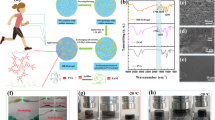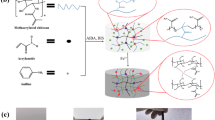Abstract
Flexible sensors for detecting strain have attracted the attention of many researchers. At present, it is an important research direction to prepare conductive hydrogels by adding different metal ions into hydrogels. In this study, a highly extensible and transparent ionic conductive hydrogel was prepared by one-step polymerization. Using sodium chloride as ionic conductive medium, interpenetrating network ionic conductive hydrogels with good flexibility, conductivity, and self-viscosity were constructed. The network is composed of graft copolymer polyacrylamide-acrylic acid (PAMAA) and biomass polymer sodium alginate (SA). Chemical and physical crosslinking have significant tensile properties for hydrogel. Because of the addition of sodium chloride, the hydrogel has excellent electrical conductivity. The SA/PAMAA-GL/NaCl conductive hydrogel can be adhered to different surfaces, such as glass, plastic, iron clip, copper sheet, and skin. The conductive hydrogel can be used as stress sensor, and the sensor is sensitive to the small strain and large strain. This conductive hydrogel has potential application prospects in flexible wearable electronic equipment, motion monitoring, medical rehabilitation, and other fields.






Similar content being viewed by others
Data availability
All data are available.
References
F. Huang, W. Wei, Q. Fan, L. Li, M. Zhao, Z. Zhou, Super-stretchable and adhesive cellulose Nanofiber-reinforced conductive nanocomposite hydrogel for wearable Motion-monitoring sensor. J. Colloid. Interf. Sci. 615, 215–226 (2022)
L. Zhang, X. Zhang, H. Zhang, L. Xu, D. Wang, XLu.A. Zhang, Semi-embedded robust MXene/AgNW sensor with self-healing, high sensitivity and a wide range for motion detection. Chem. Eng. J. 434(15), 134751 (2022)
H. Wang, S.K. Biswas, S. Zhu, Y. Li, H. Xiao, Self-healable electro-conductive hydrogels based on core-shell structured nanocellulose/carbon nanotubes hybrids for use as flexible supercapacitors. Nanomaterials 10(1), 112 (2020)
J. Han, S. Wang, S. Zhu, C. Huang, Y. Yue, Electrospun core-shell nanofibrous membranes with nanocellulose-stabilized carbon nanotubes for use as high-performance flexible supercapacitor electrodes with enhanced water resistance, thermal stability, and mechanical toughness. ACS appl. Mater. Inter. 11(47), 44624–44635 (2019)
Y. Jiao, Y. Lu, K. Lu, Y. Yue, X. Xu, H. Xiao, J. Li, J. Han, Highly stretchable and self-healing cellulose nanofiber-mediated conductive hydrogel towards strain sensing application. J. Colloid Interf. Sci. 597, 171–181 (2021)
Y. Jiao, K. Lu, Y. Lu, Y. Yue, X. Xu, H. Xiao, J. Li, J. Han, Highly viscoelastic, stretchable, conductive, and self-healing strain sensors based on cellulose nanofibers-reinforced polyacrylic acid hydrogel. Cellulose 28, 4295–4311 (2021)
C. Zheng, K. Lu, Y. Lu, S. Zhu, Y. Yue, X. Xu, C. Mei, H. Xiao, Q. Wu, J. Han, A stretchable, self-healing conductive hydrogels based on nanocellulose supported graphene towards wearable monitoring of human motion. Carbohyd. Polym. 250, 116905 (2020)
J. Yu, M. Wang, C. Dang, C. Zhang, X. Feng, G. Chen, Z. Huang, H. Qi, H. Liu, J. Kang, Highly stretchable, transparent and conductive double-network ionic hydrogels for strain and pressure sensors with ultrahigh sensitivity. J. Mater. Chem. C 9, 3635–3641 (2021)
X. Huang, G. Ge, M. She, Q. Ma, Y. Lu, W. Zhao, Q. Shen, Q. Wang, J. Shao, Self-healing hydrogel with multiple dynamic interactions for multifunctional epidermal sensor. Appl. Surf. Sci. 598, 153803 (2022)
D. Zhang, Y. Tang, Y. Zhang, F. Yang, Y. Liu, X. Wang, J. Yang, X. Gong, J. Zheng, Highly stretchable, self-adhesive, biocompatible, conductive hydrogels as fully polymeric strain sensors. J. Mater. Chem. A 8, 20474–20485 (2020)
X. Zhang, Y. Peng, X. Wang, R. Ran, R. Ran, Melanin-inspired conductive hydrogel sensors with ultrahigh stretchable, self-healing, and photothermal capacities. Acs Appl. Nano Mater. 3(4), 1899–1911 (2021)
Y. Wang, B. Pang, R. Wang, Y. Ga, Y. Liu, C. Gao, An anti-freezing wearable strain sensor based on nanoarchitectonics with a highly stretchable, tough, anti-fatigue and fast self-healing composite hydrogel. Compos. Part A 160, 107039 (2022)
Q. Yan, M. Zhou, H. Fu, Study on mussel-inspired tough TA/PANI@CNCs nanocomposite hydrogels with superior self-healing and self-adhesive properties for strain sensors. Compos. Part B-Eng. 201, 108356 (2020)
Y. Liang, X. Sun, Q. Lv, Y. Shen, H. Liang, Fully physically cross-linked hydrogel as highly stretchable, tough, self-healing and sensitive strain sensors. Polymer 210, 123039 (2020)
S. Xia, S. Song, Y. Li, G. Gao, Highly sensitive and wearable gel-based sensors with dynamic physically cross-linked structure for strain-stimulus detection over a wide temperature range. J. Mater. Chem. C 7(36), 11303–11314 (2019)
S.H. Ha, S.H. Ha, M.B. Jeon, H.C. Ji, J.M. Kim, Highly sensitive and selective multidimensional resistive strain sensors based on a stiffness-variant stretchable substrate. Nanoscale 10, 5105–5113 (2018)
S. Gan, S. Bai, C. Chen, Y. Zou, Y. Sun, J. Zhao, J. Rong, Hydroxypropyl cellulose enhanced ionic conductive double-network hydrogels. Int. J. Biol. Macromol. 181(30), 418–425 (2021)
B. Pournemati, H. Tabesh, A. Jenabi, R.M. Aghdam, A.H. Rezayan, A. Poorkhalil, S.H.A. Tafti, K. Mottaghy, Injectable conductive nanocomposite hydrogels for cardiac tissue engineering: Focusing on carbon and metal-based nanostructures. Eur. Polym. J. 174(5), 111336 (2022)
J. Park, N. Jeon, S. Lee, G. Choe, E. Lee, J.Y. Lee, Conductive hydrogel constructs with three-dimensionally connected graphene networks for biomedical applications. Chem. Eng. J. 446(5), 137344 (2022)
Z. Wang, Z. Ma, S. Wang, M. Pi, X. Wang, M. Li, H. Lu, W. Cui, R. Ran, Cellulose nanocrystal/phytic acid reinforced conductive hydrogels for antifreezing and antibacterial wearable sensors. Carbohyd. Polym. 298, 120128 (2022)
L. Ya, Y.Y. Qiu, Q.Q. Ding, T.M. Chang, X.W. Xu, Q.L. Wu, H.N. Xiao, J.Q. Han, Self-recovery, fatigue-resistant, and multifunctional sensor assembled by a nanocellulose/carbon nanotube nanocomplex-mediated hydrogel. ACS Appl. Mater. Inter. 13, 50281–50297 (2021)
X. Fan, L. Zhao, Q.J. Ling, J.C. Liu, H.B. Gu, Mussel-induced nano-silver antibacterial, self-healing, self-adhesive, anti-freezing, and moisturizing dual-network organohydrogel based on SA-PBA/PVA/CNTs as flexible wearable strain sensor. Polymer 256, 125270 (2022)
Y. Jiao, K.Y. Lu, L. Ya, Y.Y. Qiu, X.W. Qiu, H.N. Xiao, J. Li, J.Q. Han, Highly viscoelastic, stretchable, conductive, and self-healing strain sensors based on cellulose nanofiber-reinforced polyacrylic acid hydrogel. Cellulose 28, 4295–4311 (2021)
L. Ya, J.Q. Han, Q.Q. Ding, Y.Y. Qiu, C.L. Xia, S.B. Ge, X.M. Dou, Q.V. Le, C. Sonne, X.L. Su, TEMPO-oxidized cellulose nanofibers/polyacrylamide hybrid hydrogel with intrinsic self-recovery and shape memory properties. Cellulose 28, 1469–1488 (2021)
Funding
This work was financially supported by the Jiangsu industry university research cooperation project (Grant No. BY2021103) and Gen guest project of Jinling Institute of Technology (Grant No.2017007).
Author information
Authors and Affiliations
Contributions
The author completed the paper alone.
Corresponding author
Ethics declarations
Conflict of interest
The authors declare that they have no conflict of interest.
Additional information
Publisher's Note
Springer Nature remains neutral with regard to jurisdictional claims in published maps and institutional affiliations.
Rights and permissions
Springer Nature or its licensor (e.g. a society or other partner) holds exclusive rights to this article under a publishing agreement with the author(s) or other rightsholder(s); author self-archiving of the accepted manuscript version of this article is solely governed by the terms of such publishing agreement and applicable law.
About this article
Cite this article
Zhang, X. High-sensitivity antidrying hydrogel sensor with interpenetrating network crosslinking structure. J Mater Sci: Mater Electron 34, 540 (2023). https://doi.org/10.1007/s10854-023-10006-8
Received:
Accepted:
Published:
DOI: https://doi.org/10.1007/s10854-023-10006-8




